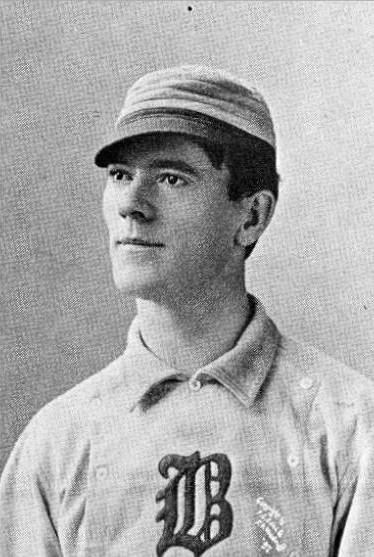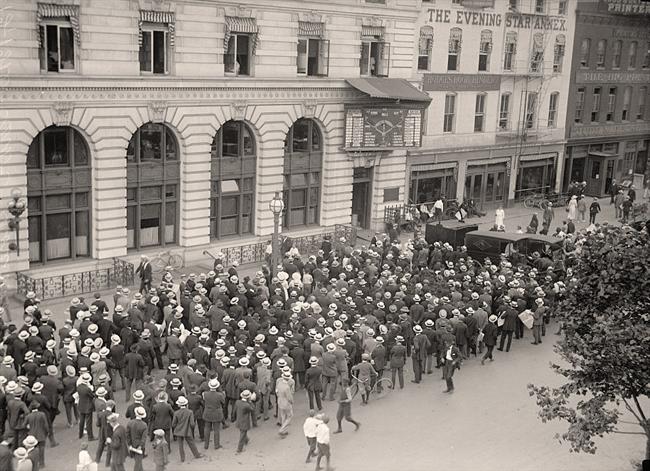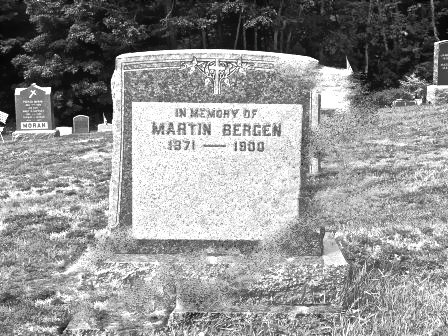
“…Mrs. Bergen was lying on the bed, with her hands raised as if in supplication or trying to ward off a blow. The little boy was lying on the floor with a large wound in the head. Mrs. Bergen’s skull was terribly crushed, having evidently been struck more than one blow by the infuriated husband. The appearance of the little girl also showed that a number of savage blows had been rained upon the top and side of her head. Bergen’s throat…”
From the New York Times, Saturday, Jan. 20th, 1900.
Superstition and sports are like peas and carrots, and nowhere is that more prevalent than in baseball. From the starting pitcher leaping over the baseline to the designated hitter not changing his socks after busting a slump. Wade Boggs ate chicken before every game. Jason Giambi wore a gold thong.
Superstition also breeds ghosts—or perhaps it’s the other way around? Therefore, it’s understandable that ghosts and baseball make terrific bedfellows. Tales have been told about the haunted Detroit row house of America’s Original Asshole, Ty Cobb. Additionally, Cobb is said to haunt Comerica Park, a rather puzzling occurrence since he died some 38 years before it was built. Babe Ruth’s portly ghost can be found at old Yankees Stadium, new Yankees Stadium, Fenway Park and a former bordello in Marlborough, MA. Busy apparition.
But this isn’t a story about ghosts, per se, but about the violence that breeds them. Murder and madness are more frightening than any campfire tale because they’re real, tangible acts of desperation, not some unseen terror peeking out from a closet door left slightly ajar.
This is the tale of Marty Bergen, one of the craziest, scariest, most unpredictable men to ever play professional baseball.
It begins, innocently enough, in 1892 with an ‘imaginary grievance’. Bergen, then a 21 year-old slick-fielding, inconsistent-hitting catcher, assaulted a teammate in Salem, Massachusetts after a perceived slight. This was the first—though hardly last—manifestation of Bergen’s mental incongruities. From that point on, no one was safe from his wild, delusional fantasies. Talent means a lot in sports, however, and most owners, fans and teammates are willing to look the other way if a few ‘eccentricities’ are outweighed by the player’s on-field value.
And Bergen could play.
With a “bull-whip” for an arm and an innate ability to block the plate, he was a valued ballplayer anywhere he took the field. After playing throughout the Northeast through much of 1893 and ’94, Bergen’s contract was purchased by the Kansas City Blues, then a “Western League” team.
[Aside about the strangely tragic Kansas City Blues (1888-1954): The Blues started out as a “Western League” team in the American Association. They operated independently throughout their early existence, and in 1936, became a successful minor league affiliate of the New York Yankees. Among their more unfortunate souls: Morrie Rath (2nd baseman, suicide at age 58), Drummond Brown (catcher, became a Kansas City cop after retirement, shot and killed himself at age 41), Chet Chadbourne (outfielder, died of a self-inflicted gunshot wound at age 58) and my personal favorite, Pea Ridge Day. Day, a pitcher and professional hog-caller (yep), slit his throat with a hunting knife at age 34, after a surgery to repair his injured throwing shoulder proved unsuccessful.]
Bergen performed above expectations in Kansas City, batting an impressive .372 and causing the Star to note in a June, 1895 article, “He is one of the cleanest hitters that ever played in Kansas City.”
Once again, however, his illness took a sorrowful hold. After yet another incident– this one again involving the assault of a teammate– Bergen headed back to Massachusetts, where his wife Hattie lived on their farm.
When the Boston Beaneaters’ regular catcher lost his legs trying to hop a train, they called upon the services of the young man who’d found such great success half the country over.
Bergen acclimated himself effusively, and in doing so, helped Boston win the National League title in ’98. He wasn’t in his right mind, however, and that soon became glaringly apparent to teammates and management alike.
He was irrational, argumentative, sullen and aggressive – sometimes all at once.
The manifestations of his madness grew progressively worse. He was intensely paranoid, thinking at various times that his wife, the team doctor and his team itself were out to kill him. He complained of hearing voices, and spoke of the desire to harm himself and others. On train trips, he feared attacks by would-be, invisible assassins and refused to talk to his “back-stabbing” teammates. 
The depth of his insanity was revealed in a disturbing public manner in a late season game in ’99 against Philadelphia. While behind the plate, Bergen would leap out of the way of incoming pitches. When the manager finally grew weary of his shenanigans—and one would assume it didn’t take long—the catcher explained that there was a man next to him at the plate who was repeatedly attempting to stab him with a knife. Bergen was subsequently removed from the game.
In modern times, it’s almost a given that he’d be given a multi-faceted diagnosis—probably bipolarity and schizophrenia, to name but two. In 1899, however, after returning to the team following a particularly bad spell—the team was struggling, the crowds were out to get him and his four-year-old son died of diphtheria—he was diagnosed by a team physician as suffering from “tobacco heart,” a by-product of too much smoking and chewing.
After the disastrous campaign ended and Bergen went back to his wife and kids on the farm, he grew stimore erratic. He discarded an elixir given to him by the family doctor because he feared that “the National League" was conspiring to poison him. He complained of crows screeching in his head at all hours of the day. At the drugstore, a few days before his heinous dénouement, someone asked him if he’d be back playing ball come springtime. He announced matter-of-factly that no, he’d never play ball again.
The next morning, before anyone else was awake, Bergen took to the shed where he procured an axe. In what surely must have been a black, psychotic void of complete disassociation, he made his way back into the house, and to the bedroom where his wife slept peacefully.
With one practiced, professional ballplayer’s swing, he brought the blade down into her head, killing her instantly. Unsatisfied with his handiwork, he kept up his savagery until there was nothing left on the pillow but a gooey mass of blood, brains and hair.
As the children came rushing from their room, he fell his three-year-old son Joe with another mighty hack, scalping him with the dripping blade. And though six-year-old Florence hid, he caught her as well, splitting her face with one powerful thrust before powdering her skull with furious chops.
Almost immediately after the frenzy, Marty Bergen, one of the greatest defensive catchers in the game, took a straight razor to his own neck with a force so hard, he nearly decapitated himself.
He was 28.
When neighbors heard of the crime, they peeked into the windows of the farmhouse to see the carnage for themselves. They were treated to what had to have been one of the most gruesome crime scenes ever, a real-life slaughterhouse with human beings playing the parts of cattle.
 Though 1,500 mourners attended the funeral, only two baseball men made it: a former teammate of Bergen’s and the legendary Connie Mack, then a 37 year old manager for the Milwaukee Brewers. Perhaps there was guilt from his former Boston teammates, for not doing something before things got out of hand, or perhaps, they just plain didn’t care for Bergen.
Though 1,500 mourners attended the funeral, only two baseball men made it: a former teammate of Bergen’s and the legendary Connie Mack, then a 37 year old manager for the Milwaukee Brewers. Perhaps there was guilt from his former Boston teammates, for not doing something before things got out of hand, or perhaps, they just plain didn’t care for Bergen.
And although there are no longstanding tales of spooks and haunts terrorizing the farm where so much violence descended on that cold January morning, it’s a safe bet that if there are such a thing as ghosts, they’re likely wandering around those fields where the house of horrors—long since razed—once stood. Many parapsychologists believe that traumatic death leads to an unsettled afterlife; if that’s the case, it’s unlikely that the Bergen family will ever stop roaming the place where they met their bloody, disturbing demise.










That is a sad tale
Wow.
The only thing new
is the history we don’t know.
Nice work. Friday night I got a tour through the earliest of baseball leagues and you now bring a slice of life (no pun) for us to devour.
Dang
Never heard that one before. Keep up the good writing.
… nice story …
…well, no, not a “nice” story, but a well written one.
Very interesting …
Wonderful Story, Scary
That was a page turner. Well done. We need more of these type of tales.
Thanks Everyone…
… for your kind words.
Great story! Shut up, Craig!